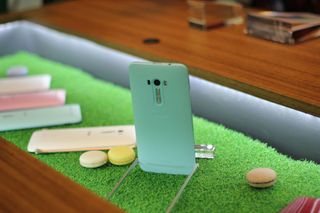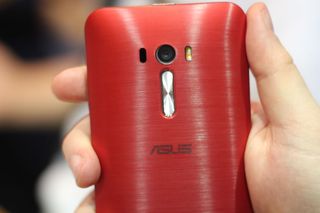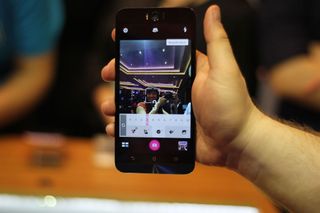Asus' New Phone Includes 360-Degree Selfie Stand
The new Asus ZenFone Selfie boasts dual 13-megapixel cameras, a Selfie-swing that folds out as a stand and nifty software features.

TAIPEI, Taiwan - Another day, another selfie phone. The latest to join the trend is Asus, which announced today (June 1) its new ZenFone Selfie smartphone. Packing dual 13-megapixel cameras (front and back), a built-in stand that rotates 360 degrees and nifty software touches for easier portrait-taking, the ZenFone Selfie is primed for the narcissist in you. Price and availability in the United States has not been announced yet.
At the company's launch event in Taiwan, I shot the best portraits I could given the immense crowd and harsh light, and was pleased to find that the ZenFone Selfie was plenty easy to use. I also liked its sleek yet sturdy construction and droolworthy assortment of colors.
MORE: Best Smartphones on the Market Now
I was most curious about how the selfie swing would work, but unfortunately, the one display unit at the exhibit was meticulously guarded by anxious Asus reps who swatted off anyone who tried to reach out to touch it. All I could deduce was that the silver cut-out rectangle attaches to the phone at the bottom via two hinges and can fold out to be used as a stand. When folded all the way around, the swing hugs the sides of the phone like a photo frame around a photo.
An Asus rep told me that the swing would come with the phone as part of a cover, so it's not technically built into the ZenFone Selfie's body.
Rocking 13-megapixel cameras and dual tone LED flashes on both its front and back, the ZenFone Selfie joins HTC Desire Eye and Lenovo Vibe Pro X2 as selfie-centric phones with similar dual 13-MP camera setups.

Asus added a laser autofocus feature on its rear shooter for steadier shots, and a selection of software touches to make it easier to snap portraits. For instance, drawing an S on the ZenFone Selfie's display when it's asleep activates the front camera. The phone also offers what Asus calls Real-Time Beautification, which lets you enhance your face by smoothing out your skin, making your cheeks smaller or enlarging your eyes, and see these changes on the viewfinder before you shoot.
Sign up to get the BEST of Tom’s Guide direct to your inbox.
Upgrade your life with a daily dose of the biggest tech news, lifestyle hacks and our curated analysis. Be the first to know about cutting-edge gadgets and the hottest deals.

While many other phones have similar software features, this is one of the more comprehensive tools I've seen, since it allows you to tweak many specific settings and the intensity of each.
MORE: How to Take a Great Selfie
The ZenFone Selfie also offers a low light mode for better selfies in dark places, selfie panorama to capture wider portraits and a super HDR mode. It runs Android 5.0 Lollipop with the company's ZenUI overlaid.
Aside from the impressive cameras, the ZenFone Selfie offers some relatively middling guts. Instead of an Intel-made processor like on the ZenFone 2, the Selfie carries an octa-core Qualcomm Snapdragon 615 CPU and features a 5.5-inch full HD display. Its screen is made with direct bonded glass, which could mean brighter and more striking image quality. It has the same volume rocker below the rear camera and top-facing power button as the ZenFone 2, as well as the slightly arched silhouette.
With a 3,000-mAh battery (bigger than on the Samsung Galaxy S6), the ZenFone Selfie could provide enough endurance for an all-day shoot, but we'd have to test it to know for sure.
Although Asus hasn't announced a price for the handset yet, a rep told me the ZenFone Selfie will be aggressively priced. Considering the impressive ZenFone 2 costs just $199 unlocked, I wouldn't be surprised if the Selfie came in at around the same ballpark. With such impressive camera features, Asus could win over masses of selfie lovers. Stay tuned for our full review.
Cherlynn Low is a Staff Writer at Tom's Guide. When she's not writing about wearables, cameras and smartphones, she's devouring old episodes of Torchwood or The X-Files. Or taking selfies. Follow Cherlynn @cherlynnlow. Follow Tom's Guide at @tomsguide and on Facebook.
Cherlynn is Deputy Editor, Reviews at Engadget and also leads the site's Google reporting. She graduated with a Master’s in Journalism from Columbia University before joining Tom's Guide and its sister site LaptopMag as a staff writer, where she covered wearables, cameras, laptops, computers and smartphones, among many other subjects.

